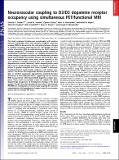Neurovascular coupling to D2/D3 dopamine receptor occupancy using simultaneous PET/functional MRI
Author(s)
Sander, Christin Yen-Ming; Rosen, Bruce R.; Hooker, Jacob M.; Catana, Ciprian; Normandin, Marc D.; Alpert, Nathaniel M.; Knudsen, Gitte M.; Vanduffel, Wim; Mandeville, Joseph B.; ... Show more Show less
DownloadSander-2013-Neurovascular coupli.pdf (869.5Kb)
PUBLISHER_POLICY
Publisher Policy
Article is made available in accordance with the publisher's policy and may be subject to US copyright law. Please refer to the publisher's site for terms of use.
Terms of use
Metadata
Show full item recordAbstract
This study employed simultaneous neuroimaging with positron emission tomography (PET) and functional magnetic resonance imaging (fMRI) to demonstrate the relationship between changes in receptor occupancy measured by PET and changes in brain activity inferred by fMRI. By administering the D2/D3 dopamine receptor antagonist [[superscript 11]C]raclopride at varying specific activities to anesthetized nonhuman primates, we mapped associations between changes in receptor occupancy and hemodynamics [cerebral blood volume (CBV)] in the domains of space, time, and dose. Mass doses of raclopride above tracer levels caused increases in CBV and reductions in binding potential that were localized to the dopamine-rich striatum. Moreover, similar temporal profiles were observed for specific binding estimates and changes in CBV. Injection of graded raclopride mass doses revealed a monotonic coupling between neurovascular responses and receptor occupancies. The distinct CBV magnitudes between putamen and caudate at matched occupancies approximately matched literature differences in basal dopamine levels, suggesting that the relative fMRI measurements reflect basal D2/D3 dopamine receptor occupancy. These results can provide a basis for models that relate dopaminergic occupancies to hemodynamic changes in the basal ganglia. Overall, these data demonstrate the utility of simultaneous PET/fMRI for investigations of neurovascular coupling that correlate neurochemistry with hemodynamic changes in vivo for any receptor system with an available PET tracer.
Date issued
2013-07Department
Harvard University--MIT Division of Health Sciences and Technology; Massachusetts Institute of Technology. Department of Electrical Engineering and Computer ScienceJournal
Proceedings of the National Academy of Sciences
Publisher
National Academy of Sciences (U.S.)
Citation
Sander, C. Y., J. M. Hooker, C. Catana, M. D. Normandin, N. M. Alpert, G. M. Knudsen, W. Vanduffel, B. R. Rosen, and J. B. Mandeville. “Neurovascular Coupling to D2/D3 Dopamine Receptor Occupancy Using Simultaneous PET/functional MRI.” Proceedings of the National Academy of Sciences 110, no. 27 (July 2, 2013): 11169–11174.
Version: Final published version
ISSN
0027-8424
1091-6490